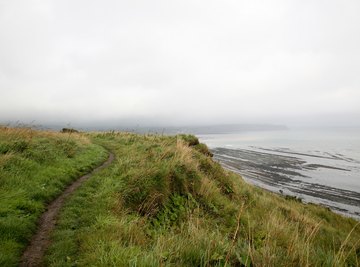
Found in the southeast region of the United States, the state of Mississippi lies on the eastern shore of the Mississippi River. The state is mostly flat and the highest point is only 800 feet (240 meters) above sea level. Regions include the dark alluvial soils of floodplains in the northwest, loess bluffs and fertile prairies in the center, and the Tennessee Hills in the northeast. In the south are sandy coastal soils, with the southern border adjoining the Gulf of Mexico. The state has a humid subtropical climate, with an annual precipitation of between 50 and 65 inches. The state of Mississippi has diverse range of animals and plants that live in the grasslands, forests, wetlands and floodplains.
Broadleaf Forest and Oak Savanna
The forests and oak savanna ecosystems of Mississippi contain a large number of tree species. They contain a high diversity of oaks (Quercus spp.), such as Southern red oak (Q. falcata), evergreen live oak (Q. virginiana) and turkey oak (Q. laevis). Other types of trees include maples (Acer spp.), dogwoods (Cornus spp.), elms (Ulmus spp.) and hollies (Ilex spp.).
Broadleaf forest was the original habitat of the southern magnolia (Magnolia grandiflora). This is the most iconic plant in the state, representing both the state tree and the state flower, and is a popular ornamental plant. It has thick, dark green leaves which it retains throughout the year and white flowers up to 12 inches across. It grows well in warmer climates, favoring plant hardiness zones between 6a and 10b, and prefers deep, well-drained soils with neutral or acidic pH.
Mississippi Wildlife in Forests
Mississippi forests and savannas are home to an impressive range of wildlife. Common mammals include skunks, squirrels, raccoons and the white-tailed deer, which is the Mississippi state animal and is found throughout these habitats.
Bird species in these ecosystems include the Northern Cardinal, Blue Jay and Red-bellied Woodpecker, as well as owls, hawks and other raptors. Many of these species are often found in backyards and parks in urban areas.
This includes the Northern Mockingbird (Mimus polyglottos), which is the state bird of Mississippi. It is a small gray bird identifiable by the patches of white on its tail and wings. It prefers open areas such as farmland, gardens, roadsides and forest edges. It was named "mockingbird" for its ability to imitate sounds, often mimicking the calls of other birds. They are also very territorial, known to attack cats, dogs and humans who approach their nest.
There are predators such as bobcats and black bears in Mississippi, but their populations have been dramatically reduced through hunting and habitat lost. Wolves and puma once lived in the region but are now extinct in the state.
Temperate Pine Forest Plants and Wildlife
The pine forests and savannas found on the sandier soils in the south are part of the southeastern conifer forest. This region is the largest expanse of conifer vegetation east of the Mississippi, with diverse tree species and many endemic mammals, reptiles and amphibians. Tree species commonly found in this ecosystem include slash pine (Pinus elliottii) and longleaf pine (P. palustris).
Mississippi Wildlife and Plants in Prairie Grasslands
The Black Belt and the Jackson Prairie Belt are the home of prairie ecosystems in Mississippi. These are called tallgrass prairies, and feature grasses such as big bluestem (Andropogon gerardi) and Indian grass (Sorghastrum nutans) which grow up to eight feet in height.
Prairie wildlife includes rabbits, gophers and grassland birds like grouse and quail. These grasslands also contain many wildflower species, including the Mississippi wildflower emblem lance-leaf Coreopsis (Coreopsis lanceolata). Other Mississippi wildflowers include purple coneflower ( Echinacea purpurea), New England aster (Symphyotrichum novaeangliae) and black-eyed Susan (Rudbeckia hirta).
Due to the conversion of prairies to farmland in order to produce cotton and other crops on the fertile soil, very few areas of prairie remain in Mississippi. Remaining prairie lands exist only as small patches in a highly fragmented landscape.
Mississippi Wildlife and Plants in Delta Wetlands
In the low-lying floodplains along the Mississippi River there exist numerous marshes, swamps and wetlands. In forested areas, the dominant trees are bald cypress (Taxodium distichum) and water tupelo (Nyssa aquatica), giving them their common name of Cypress-Tupelo swamps. These trees have adaptations which allow them to survive in permanently waterlogged, oxygen-poor soils which often contain high levels of toxic compounds.
Mississippi wetlands contain mammals such as beavers and muskrats, reptiles including alligators, turtles and snakes, and a diversity of frogs, fish and wading birds like ducks, geese, herons and ibis. Wetland areas are at risk from logging, flood control, drainage construction and land reclamation activities, with only about 58 percent of their original extent remaining.
References
- Plant Native: Native Plant List For Georgia, Alabama and Mississippi
- National Park Service: Nature - Mississippi National River and Recreation Area
- Gardening Know How: Southern Magnolia Facts
- Mississippi State University: Mississippi Climate
- Audobon Field Guide: Northern Mockingbird
- World Wildlife Fund: Southeastern Conifer Forests
- Wildlife Mississippi: Native Prairie Handbook
About the Author
Born and raised in Western Australia, I have been fascinated by the natural world for as long as I can remember. I studied Conservation Biology at Murdoch University before working as a government field researcher, project leader for community-led bushland regeneration programs, private botanical consultant and environmental educator. Although fascinated by all things ecological, a particular interest is regenerative agriculture and its potential to help transform our entire relationship with the natural world in which we depend.
Photo Credits
Jupiterimages/Photos.com/Getty Images
